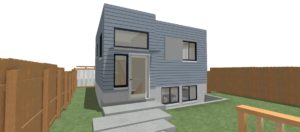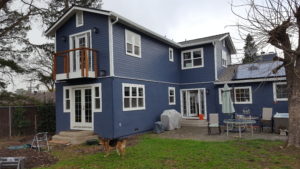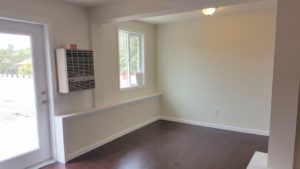Free-standing Building

This is the quintessential accessory dwelling. Often called a back yard cottage, a guest house, or a casita. These are free standing structures that sit in your back yard. Depending on the size of your property, and your local zoning restrictions, they can be small or have multiple bedrooms. New ones are rare in San Francisco, but they are common in Berkeley, Oakland, and other Bay Area jurisdictions.
In Berkeley and Oakland, they are limited to no more than 14 feet tall (no second floors, no lofts). Both cities allow a free standing ADU to be only 4 feet from the side and rear property lines.
Garage Conversion
Many older properties have existing free-standing garages. These can often be converted into accessory dwellings. The rules governing such a conversion will vary from jurisdiction to jurisdiction.
Two things in particular to watch out for in this kind of conversion, is the affect of the garage’s location on the property. If the garage is too close to the property line, the walls have to be upgraded to have a fire rating, usually of one hour. That often means, depending on how close to the property line it is, that there can be no windows on that wall.
Also, because garages are considered a storage occupancy, in California at least, you will be required to bring the existing structure into compliance with the current structural code. Depending on the age and condition of your garage, this could be a significant cost.
Addition

Most cities will allow you to add on to your existing house and make the addition the accessory dwelling. In every jurisdiction that I’ve worked in, an addition to the existing house has to comply with the required set-backs (the distance from the property line that is allowed by the local zoning code).
Many houses were built before the current codes came into affect. In some jurisdictions, the addition can follow the line of an existing wall, even if the wall is too close to the property line. In most jurisdictions, however, the new addition must meet the current set-back requirements.
The benefit of an addition as an accessory dwelling, is that the height limit is usually the same as for the main house, so you can have a second floor or loft in the accessory dwelling.
In-law Unit or garden apartment

This is the most common type of accessory dwelling in San Francisco. In this type of accessory dwelling, all or a portion of the ground floor of the existing house is the accessory structure. In most cases, the accessory apartment is at the back of the house behind the garage which faces the street.
If your San Francisco house still has a full garage, running from the front of the house to the back of the house, you can usually build a small 1 bedroom apartment that faces the back yard. San Francisco only allows very minor additions to houses (filling in under bay windows, and similarly small additions); generally the new unit has to be entirely within the existing envelope of the building.
Legalizing an existing secondary unit that was built without permits
Many San Francisco houses have existing in-law units that were built without permits. These can be legalized under the City’s legalization program, but you are required to bring the in-law unit into compliance with the current building code which can be quite expensive in some cases. The City will also make you comply with a handful of Planning requirements that will add to the cost.
Currently, if your illegal in-law unit meets the requirements to be included in the San Francisco program, the plan check fees are waived. If you have received a Notice of Violation/Abatement from the City of San Francisco because of your illegal in-law unit, if you legalize the unit in their program, not only are the plan check fees waived, but the penalty fine is waived. This is no small matter as the fine is 9x the cost of the building permit (often around $50,000).
Subdivide
If you have a large single family home, you can consider splitting it into two dwellings, one larger than the other.
The reason one has to be larger than the other, and their may be a maximum square footage for the accessory dwelling’s size or a specific ratio between the two unit sizes to meet, is that accessory dwellings cannot compete with the main dwelling. They are intended to be accessory to the zoned use of the property which, in most cases is being a single family home. Converting a single family home into a duplex – two more or less equally sized dwellings – is normally not permitted unless your jurisdiction allows duplex apartments in your neighborhood.
